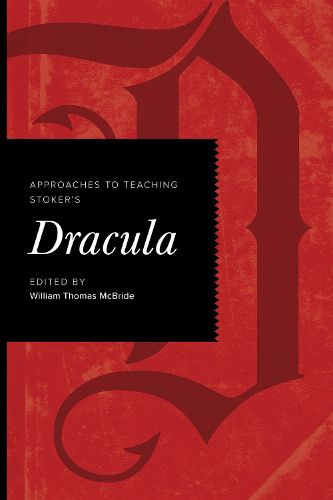Readings Newsletter
Become a Readings Member to make your shopping experience even easier.
Sign in or sign up for free!
You’re not far away from qualifying for FREE standard shipping within Australia
You’ve qualified for FREE standard shipping within Australia
The cart is loading…






Essays on teaching the most influential vampire novel of all time
This volume helps teachers contextualize Bram Stoker's Dracula in its historical and cultural moment, considering psychology, technology, gender roles, colonialism, and anxieties about the other. It also situates the novel among the kindred texts that have proliferated since its publication, from film and television to the growing genre of vampire novels.
Essays explore the novel in terms of medical humanities, contagion, and the gothic as well as ethnicity, identity, and race. Contributors analyze Dracula in the context of various ancient and modern cultural productions, including classical Indian aesthetics and African American vampire literature, and describe a broad range of classroom settings, including a technical university, a Hispanic-serving institution, and others.
This volume contains discussion of Fury of Dracula (board game; 1987); Castlevania: Lords of Shadow (video game); Penny Dreadful (television series); Dracula (television adaptation; 2013); Nosferatu (film; dir. F. W. Murnau; 1922); Dracula (film; dir. Tod Browning; 1931); Bram Stoker's Dracula (film; dir. Francis Ford Coppola; 1992); Blacula (film; dir. William Crain; 1972); The Castle of Otranto (novel; Horace Walpole, 1764); Frankenstein (novel; Mary Shelley, 1818); The Vampyre (novella; John Polidori, 1819); The Horror of Dracula (film; dir. Terence Fisher; 1958); "Leixlip Castle" (story; Charles Maturin, 1825); "The Fortunes of Sir Robert Ardagh" (story; Joseph Sheridan Le Fanu, 1838); "Ultor de Lacy" (story; Joseph Sheridan Le Fanu, 1861); Melmoth the Wanderer: A Tale (novel; Charles Maturin, 1820); In a Glass Darkly (stories; Joseph Sheridan Le Fanu, 1872); Reading in the Dark (novel; Seamus Deane, 1996); Mistaken (novel; Neil Jordan, 2011).
$9.00 standard shipping within Australia
FREE standard shipping within Australia for orders over $100.00
Express & International shipping calculated at checkout
Essays on teaching the most influential vampire novel of all time
This volume helps teachers contextualize Bram Stoker's Dracula in its historical and cultural moment, considering psychology, technology, gender roles, colonialism, and anxieties about the other. It also situates the novel among the kindred texts that have proliferated since its publication, from film and television to the growing genre of vampire novels.
Essays explore the novel in terms of medical humanities, contagion, and the gothic as well as ethnicity, identity, and race. Contributors analyze Dracula in the context of various ancient and modern cultural productions, including classical Indian aesthetics and African American vampire literature, and describe a broad range of classroom settings, including a technical university, a Hispanic-serving institution, and others.
This volume contains discussion of Fury of Dracula (board game; 1987); Castlevania: Lords of Shadow (video game); Penny Dreadful (television series); Dracula (television adaptation; 2013); Nosferatu (film; dir. F. W. Murnau; 1922); Dracula (film; dir. Tod Browning; 1931); Bram Stoker's Dracula (film; dir. Francis Ford Coppola; 1992); Blacula (film; dir. William Crain; 1972); The Castle of Otranto (novel; Horace Walpole, 1764); Frankenstein (novel; Mary Shelley, 1818); The Vampyre (novella; John Polidori, 1819); The Horror of Dracula (film; dir. Terence Fisher; 1958); "Leixlip Castle" (story; Charles Maturin, 1825); "The Fortunes of Sir Robert Ardagh" (story; Joseph Sheridan Le Fanu, 1838); "Ultor de Lacy" (story; Joseph Sheridan Le Fanu, 1861); Melmoth the Wanderer: A Tale (novel; Charles Maturin, 1820); In a Glass Darkly (stories; Joseph Sheridan Le Fanu, 1872); Reading in the Dark (novel; Seamus Deane, 1996); Mistaken (novel; Neil Jordan, 2011).